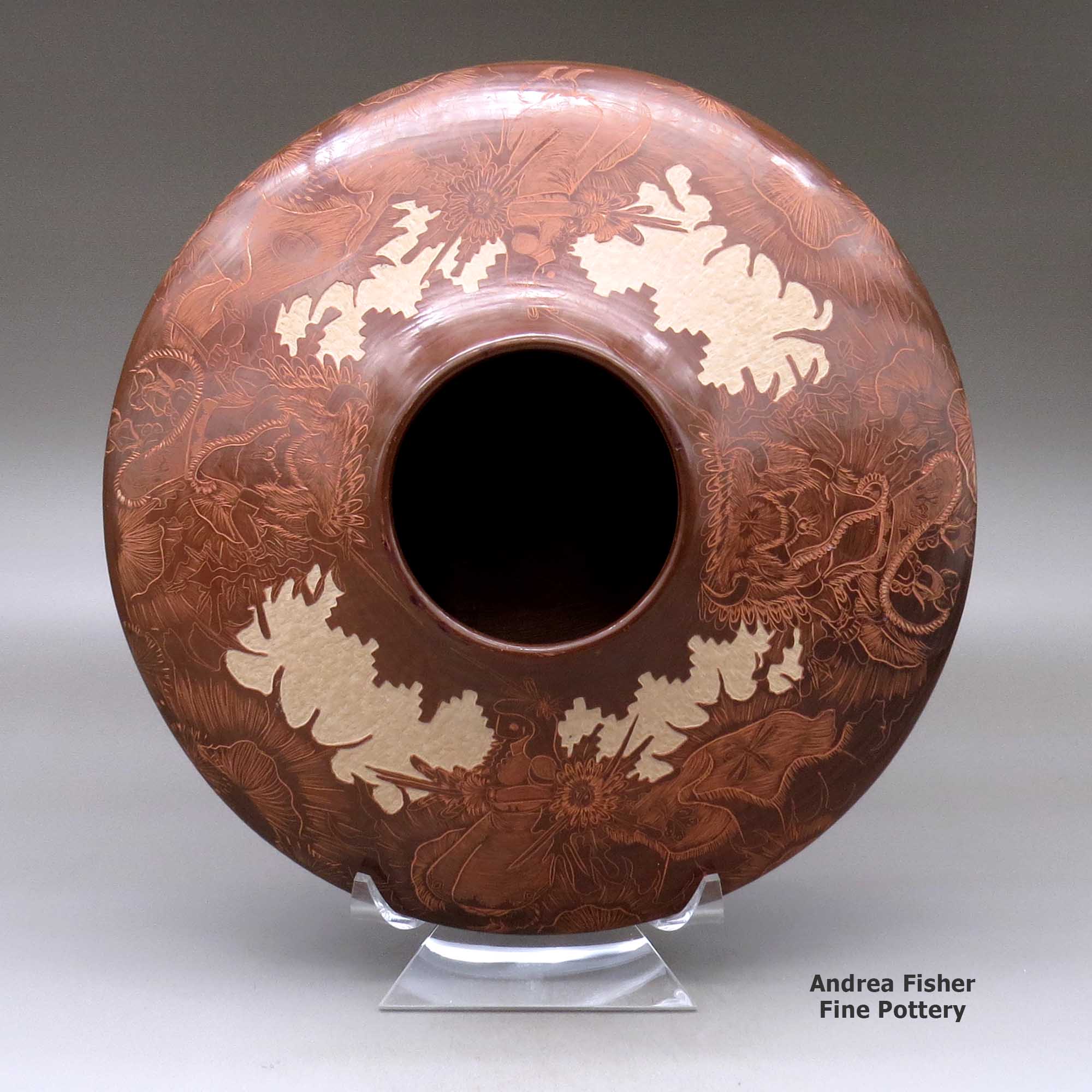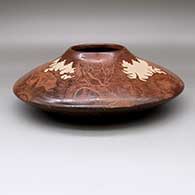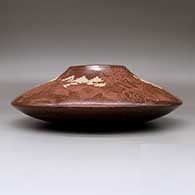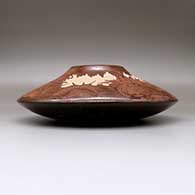
Click or tap to see a larger version
Paul Naranjo, Santa Clara, A wide, low-shouldered sepia jar decorated with a sgraffito four-panel pueblo dancer, plant and geometric design above the shoulder and sgraffito plant design below
Santa Clara
$ 2200
cjsc4j126
A wide, low-shouldered sepia jar decorated with a sgraffito four-panel pueblo dancer, plant and geometric design above the shoulder and sgraffito plant design below
13.25 in L by 13.25 in W by 4.5 in H
Condition: Very good with some small chips along the shoulder and one on the very bottom, priced accordingly
Signature: Paul Naranjo Santa Clara
Tell me more! Buy this piece!
(505) 986-1234 - www.andreafisherpottery.com - All Rights Reserved
Paul Naranjo
1957-2002
Santa Clara

Born into Santa Clara Pueblo in 1957, Paul Naranjo grew up surrounded by some of the finest traditional Native American potters on Earth. His father, Raymond Naranjo, was known for his ceramic animal figures and his ceramic models of Puye Pueblo. Paul specialized in nature and wildlife sgraffito designs on brownware pottery.
Paul also worked with Kevin Naranjo for a while, you can still see that influence in Kevin's sgraffito work. Sadly, Paul passed on in 2002.
There's not a lot of information about Paul's life but he did submit pieces for judging at the Santa Fe Indian Market and earned several awards for his work:
- His first ribbon seems to have been a Second Place ribbon for an animal figure made by a student age 12 and under.
- In 1988 he earned a Third Place ribbon for sgraffito design.
- In 1989 he earned a Second Place ribbon for a miniature black piece with sgraffito decoration.
- In 1990 he had a really good year, earning a Best of Division ribbon for non-traditional pottery (using new forms) made using traditional materials and techniques, and a First Place ribbon for sgraffito style without stones on any color except black.
- In 1991 he earned a Second Place ribbon for a black piece with sgraffito decoration and no stones, and another Second Place ribbon for sgraffito design without stones on any color except black.
- In 1992 he earned a Third Place ribbon for sgraffito decoration without stones on a black or black/two-tone piece.
Santa Clara Pueblo

Ruins at Puye Cliffs, Santa Clara Pueblo
Santa Clara Pueblo straddles the Rio Grande about 25 miles north of Santa Fe. Of all the pueblos, Santa Clara has the largest number of potters.
The ancestral roots of the Santa Clara people have been traced to ancient pueblos in the Mesa Verde region in southwestern Colorado. When that area began to get dry between about 1100 and 1300 CE, some of the people migrated eastward, then south into the Chama River Valley where they constructed several pueblos over the years. One was Poshuouinge, built about 3 miles south of what is now Abiquiu on the edge of the Jemez foothills above the Chama River. Eventually reaching two and three stories high, and with up to 700 rooms on the ground floor, Poshuouinge was occupied from about 1375 CE to about 1475. Drought then again forced the people to move, some of them going to the area of Puye (on the eastern slopes of the Pajarito Plateau of the Jemez Mountains) and others downstream to Ohkay Owingeh (San Juan Pueblo, along the Rio Grande). Beginning around 1580 CE, drought forced the residents of the Puye area to relocate closer to the Rio Grande and they founded what we now know as Santa Clara Pueblo on the west bank of the river, with San Juan Pueblo to the north and San Ildefonso Pueblo to the south.
In 1598 the seat of Spanish government was established at Yunque, near San Juan Pueblo. The Spanish proceeded to antagonize the Puebloans so badly that that government was moved to Santa Fe in 1610, for their own safety.
Spanish colonists brought the first missionaries to Santa Clara in 1598. Among the many things they forced on the people, those missionaries forced the construction of the first mission church around 1622. However, like the other pueblos, the Santa Clarans chafed under the weight of Spanish rule. As a result, they were in the forefront of the Pueblo Revolt of 1680. One Santa Clara resident, a mixed black and Tewa man named Domingo Naranjo, was one of the rebellion's ringleaders. However, the pueblo unity that allowed them to chase the Spanish out fell apart shortly after their success, especially after Popé died.
When Don Diego de Vargas came back to the area in 1694, he found most of the Santa Clarans on top of nearby Black Mesa (with the people of San Ildefonso). A six-month siege didn't subdue them so finally, the two sides negotiated a treaty and the people returned to their pueblos. However, successive invasions and occupations by northern Europeans took their toll on all the tribes over the next 250 years. Then the swine flu pandemic in 1918 almost wiped them out.
Today, Santa Clara Pueblo is home to as many as 2,600 people and they comprise probably the largest per capita number of artists of any North American tribe (estimates of the number of potters run as high as 1-in-4 residents).
Today's pottery from Santa Clara is typically either black or red. It is usually highly polished and designs might be deeply carved or etched ("sgraffito") into the pot's surface. The water serpent, (avanyu), is a very common traditional design motif on Santa Clara pottery. Another motif comes from the legend that a bear helped the people find water during a drought. The bear paw has appeared on much of their pottery ever since.
Santa Clara has received a lot of distinction because of the evolving artistry the potters have brought to their craft. Not only did this pueblo produce excellent black and redware, several notable innovations helped move pottery from the realm of utilitarian vessels into the domain of art. Different styles of polychrome redware emerged in the 1920s-1930s. In the early 1960s experiments with stone inlay, incising and double firing began. Modern potters have also extended the tradition with unusual shapes, slips and designs, illustrating what one Santa Clara potter said: "At Santa Clara, being non-traditional is the tradition." (This refers strictly to artistic expression; the method of creating pottery remains traditional).
Santa Clara Pueblo is home to a number of famous pottery families: Tafoya, Baca, Gutierrez, Naranjo, Suazo, Chavarria, Garcia, Vigil, and Tapia - to name a few.



Santa Clara Pueblo at Wikipedia
Pueblos of the Rio Grande, Daniel Gibson, ISBN-13:978-1-887896-26-9, Rio Nuevo Publishers, 2001
Upper photo courtesy of Einar Kvaran, Creative Commons Attribution-Share Alike 3.0 Unported License
Copyright © 1998-2025 by



